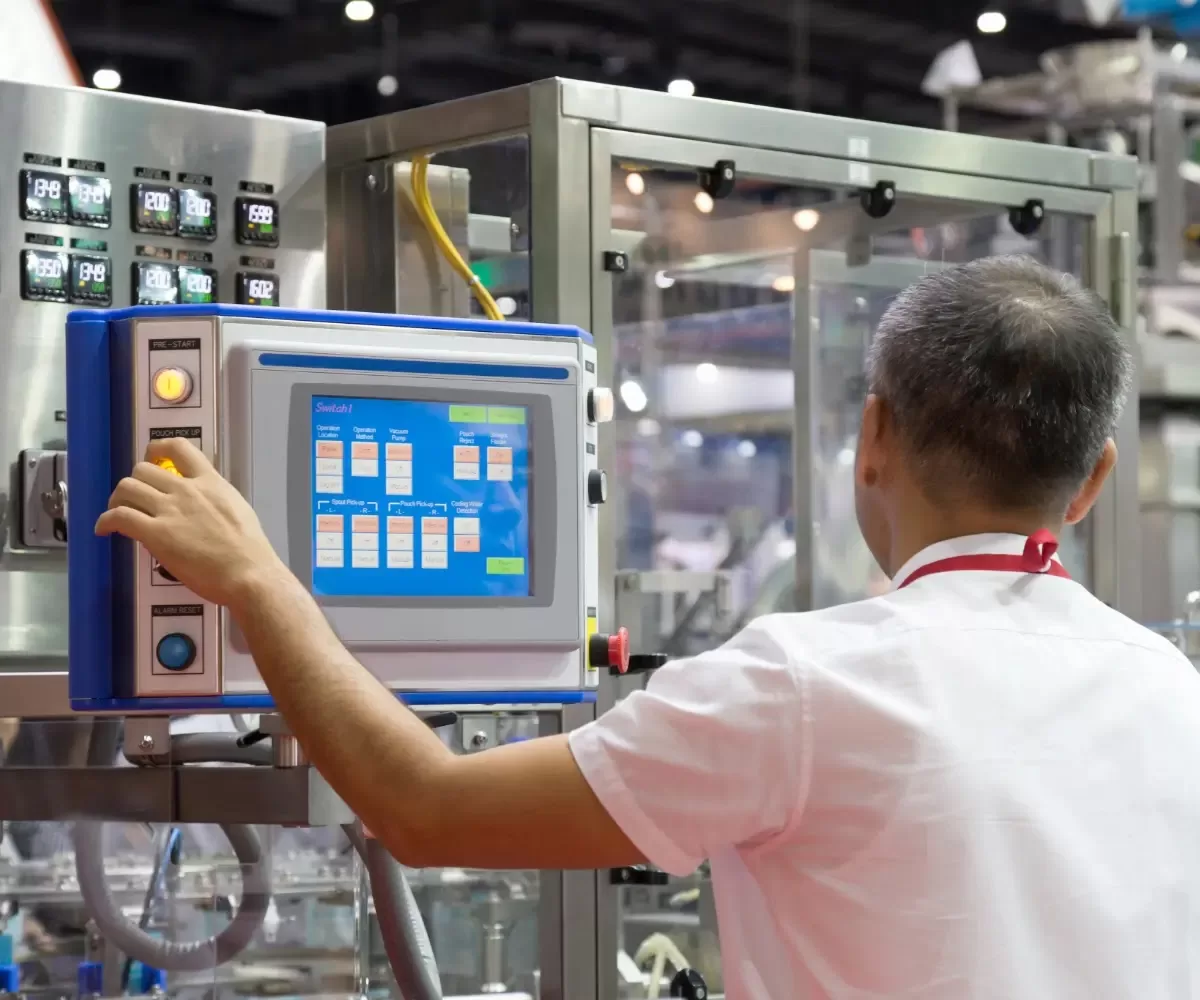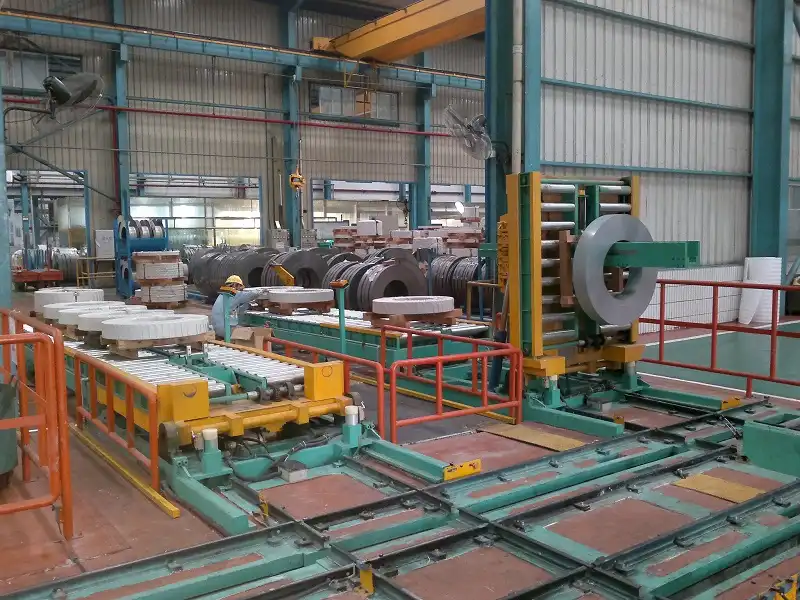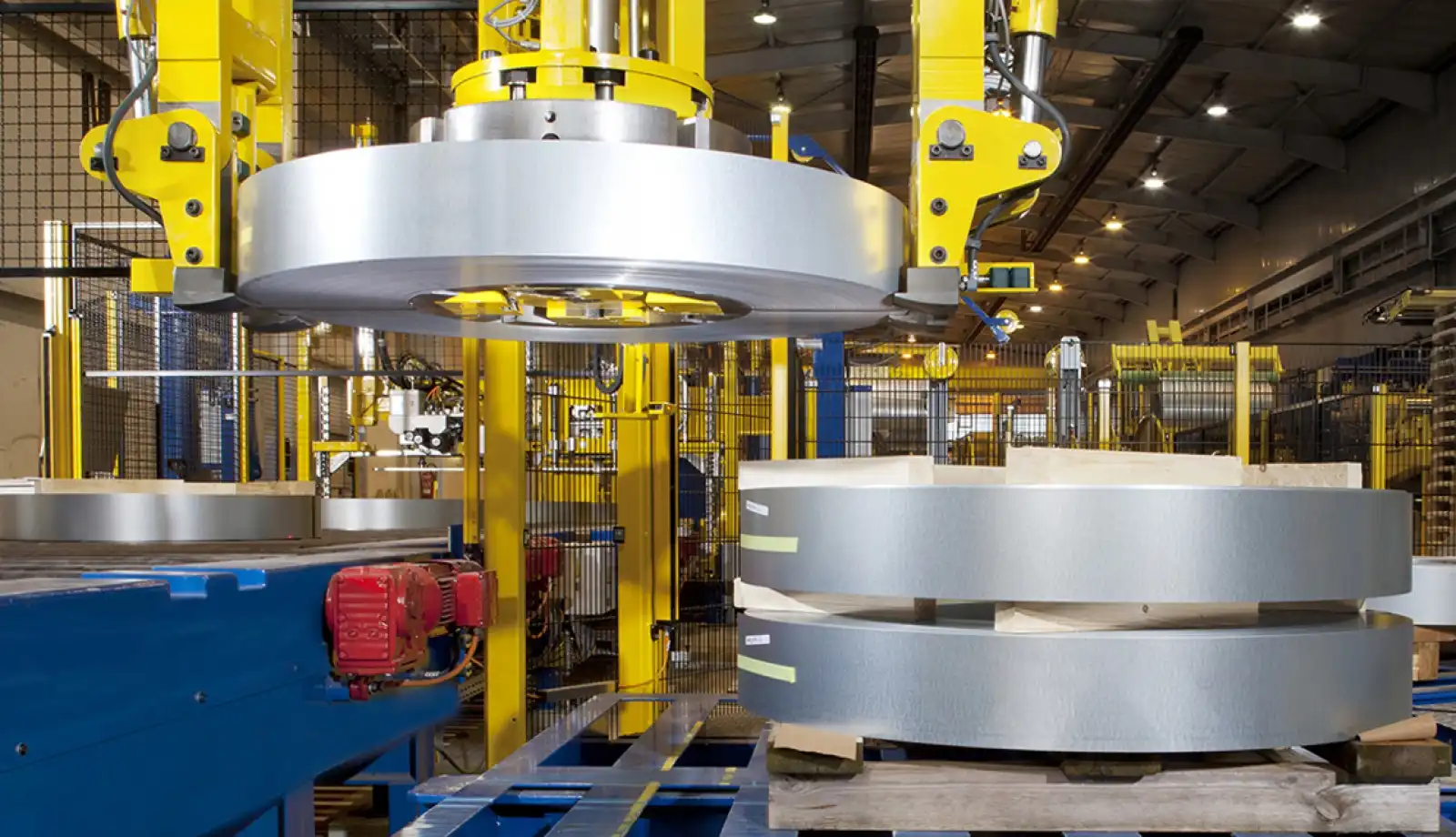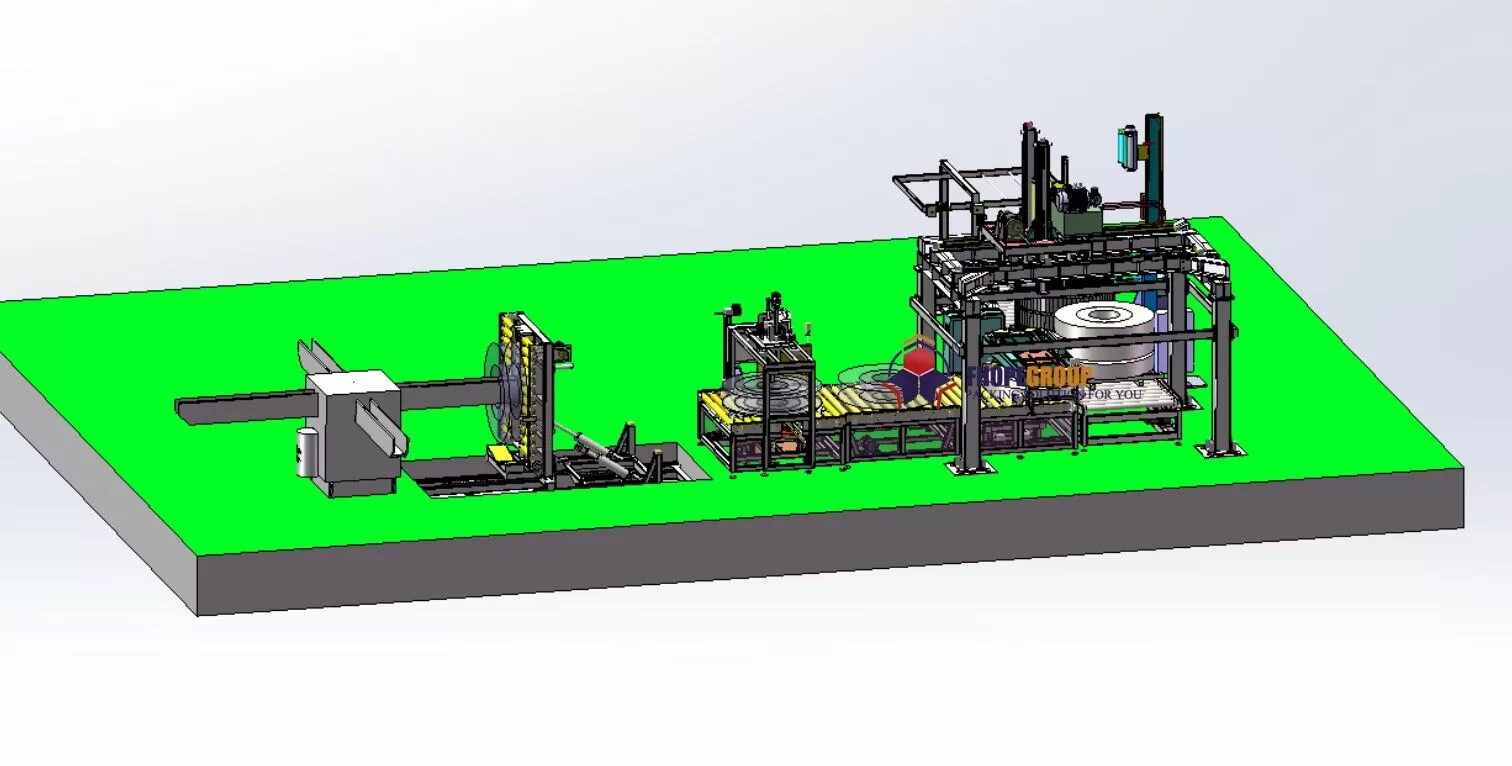Your factory floor is humming with activity, but there's a problem. The end of your production line, the packaging station, is a scene of slow, manual labor. Heavy steel coils are being painstakingly wrapped by hand, creating a bottleneck that slows down your entire operation. This inefficiency leads to delayed shipments, frustrated customers, and mounting pressure on your team. You know that every minute of downtime costs you money and that the risk of worker injury is a constant worry. But what if you could change this entire picture?
The transformation from manual to automatic coil packaging is achieved by implementing an integrated packaging line. This line automates key processes like coil loading, wrapping, strapping, and stacking. By replacing slow, inconsistent, and dangerous manual labor with reliable machinery, steel mills significantly increase throughput, enhance worker safety, and reduce product damage. This switch isn't just about buying a new machine; it's about re-engineering the final stage of your production for maximum efficiency and profitability.

I've seen this transformation firsthand, not just as a machine supplier but as someone who built and ran my own packing machine factory. I understand the daily pressures you face as a manager. You need solutions that work, are reliable, and provide a clear return on investment. This isn't just theory for me; it's experience earned on the factory floor. So, let's break down exactly how this transition works and what it can mean for your business. We will look at the core challenges—efficiency, safety, product protection, and finding the right partner—and explore the real-world solutions.
How Can Automation Break Through Your Coil Packaging Bottleneck?
Your production line is capable of producing steel coils at a high rate, but they all end up waiting at the packaging station. This manual packaging process is the choke point. Workers are trying their best, but they can only move so fast. This bottleneck limits your total output, no matter how efficient the rest of your factory is. It causes delays, creates stress, and ultimately caps your factory's growth potential. But there is a direct solution to this critical problem.
Automation breaks through the packaging bottleneck by replacing multiple slow, manual steps with a single, continuous, and fast automated process. A fully automatic coil packaging line can take a coil from the end of your slitting line, wrap it, strap it, and stack it in a fraction of the time it takes a team of workers. This eliminates waiting times and allows your packaging capacity to finally match your production speed, unlocking higher overall output for your plant.

Deconstructing the Bottleneck
Let's look deeper at the manual process versus the automated one. When I visit factories still relying on manual methods, I see a similar story every time. The process is a sequence of separate, time-consuming actions, each one a potential point of failure or delay. A worker has to wait for a crane to bring the coil. Then, they have to manually feed the packing material around and through the coil's eye. This is often awkward and slow. After wrapping, the coil needs to be moved again for strapping, another manual task. Finally, it's moved to a pallet for shipping. Each step requires manual labor, coordination, and time.
An automated system integrates these steps into a smooth, flowing line. The coil is moved from the turnstile or down-ender onto a conveyor. It travels automatically to the wrapping station. The wrapping machine, an orbital wrapper, applies the packing material consistently and quickly without any manual intervention. From there, it moves to an automatic strapping machine that applies the straps at precise points. Finally, the finished coil is conveyed to a stacking station or an exit conveyor, ready for pickup. There are no unnecessary stops. The process is continuous. This systemic change is what truly breaks the bottleneck. It’s not just about doing one step faster; it’s about making the entire sequence faster and more reliable.
| Process Step | Manual Method | Automated Method | Impact of Automation |
|---|---|---|---|
| Coil Loading | Crane or forklift operator manually places coil; high potential for delays. | Coil is automatically transferred from turnstile/down-ender to conveyor. | Eliminates waiting time; creates a continuous flow. |
| Wrapping | Workers pass wrapping material through the coil eye by hand. Slow and inconsistent. | Orbital wrapper applies material quickly and uniformly. | Drastically reduces wrapping time; improves package quality. |
| Strapping | Manual tools used to apply and tension straps. Physically demanding and slow. | Automatic strapping machine applies straps at programmed intervals. | Increases speed and consistency; reduces labor. |
| Handling | Multiple crane/forklift moves between stations. | Coil moves along an integrated conveyor system. | Minimizes handling time and risk of damage. |
| Overall Speed | Limited by the speed of the slowest worker. | Governed by machine speed, which is fast and consistent. | Increases throughput by 200-400% or more. |
This isn't just about speed. It's about predictability. With a manual process, output can vary based on who is working, how tired they are, or if there's a shift change. With an automated line, you get a predictable, consistent output rate every hour of every day. This allows you to plan your production schedules with much greater accuracy and promise delivery dates to your clients with confidence.
Is an Automated Packaging Line Truly Safer for Your Workers?
In a heavy manufacturing environment, safety is not just a policy; it's a constant concern. Manual handling of heavy steel coils is one of the most dangerous jobs in a steel mill. You see workers straining to move coils, reaching into awkward positions to wrap them, and operating heavy lifting equipment in close quarters. This environment is ripe for accidents, from serious back injuries and crushed limbs to repetitive strain injuries that develop over time. The result is not only tragic for the employee but also costly for the company, with high insurance premiums, lost workdays, and high employee turnover.
Yes, an automated packaging line is fundamentally safer for your workers. It achieves this by removing the need for manual handling of heavy loads almost entirely. The system takes over the dangerous tasks of lifting, turning, and manipulating the coils. Workers are no longer in the line of fire. They transition from performing physically dangerous labor to supervising a machine from a safe distance. This dramatically reduces the risk of serious injuries and creates a much safer work environment for your team.

A Detailed Look at Safety Improvements
To truly appreciate the safety impact, we need to compare the specific risks of manual operations with the safety features of an automated line. I remember a conversation with a factory manager who was hesitant about the investment. His biggest concern was an aging workforce and the physical toll the job was taking on them. He was seeing more and more reports of back pain and close calls with forklift accidents. This is a common story.
Let's break down the risks. Manual lifting of coils, even with crane assistance, puts workers in hazardous proximity to a suspended, multi-ton load. Any failure in the lifting gear can be catastrophic. The act of manually wrapping a coil requires workers to repeatedly pass material through the coil's inner diameter, a motion that can lead to shoulder and back injuries over time. Using manual strapping tools involves tensioning steel or plastic bands, which can snap back and cause serious cuts or eye injuries.
An automated system is designed to eliminate these specific risks.
From High-Risk Tasks to Safe Supervision
| Manual Task Risk | How Automation Eliminates the Risk |
|---|---|
| Crushing/Impact from Moving Coils | Coils are moved on automated conveyors with light curtains and physical guards. Workers are kept out of the movement path. |
| Back/Shoulder Strain | The orbital wrapper performs the wrapping. The coil tilter safely repositions the coil. No manual lifting or awkward reaching is needed. |
| Hand and Finger Injuries | Workers no longer feed packing material by hand. All wrapping and strapping are done by machine mechanisms, away from human hands. |
| Falls and Trips | A streamlined automated line reduces clutter on the factory floor. There are fewer stray materials or tools for workers to trip over. |
| Repetitive Strain Injury (RSI) | The repetitive, physically demanding tasks are now done by the machine. The worker's role shifts to monitoring and control. |
The role of the employee changes completely. They are no longer a source of manual power but a system operator. Their job becomes about managing the workflow through a control panel, loading new packing materials from a safe position, and performing routine maintenance checks. This is not only safer but also a more skilled and engaging role. By investing in automation, you are not just protecting your employees from harm; you are investing in a more skilled and sustainable workforce. The reduction in injuries, insurance costs, and employee turnover provides a clear and compelling return on investment that goes far beyond just production speed.
How Does an Automated System Protect Your Coils and Your Bottom Line?
You work hard to produce high-quality steel coils, but the journey isn't over until they reach the customer in perfect condition. In a manual packaging process, however, products are highly susceptible to damage. A slight bump from a forklift, an improperly tensioned strap, or inconsistent wrapping can cause scratches, dents on the coil edge, or telescoping. Each damaged coil represents a direct loss—either through scrap, rework costs, or customer complaints that damage your reputation and lead to lost future business.
An automated system protects your coils and your bottom line by providing gentle, precise, and consistent handling and wrapping. Automated conveyors move coils smoothly without the jolts of a forklift. The orbital wrapper applies packing material with uniform tension, creating a tight, protective cocoon around the entire coil, including the vulnerable edges. This consistency minimizes product damage, reduces customer claims, and directly protects your profitability.

The Financial Impact of Superior Protection
Let's dig into the specific ways damage occurs and how automation prevents it. I once worked with a client who was losing nearly 3% of their finished product value to damage during in-plant handling and packaging. It was a silent drain on their profits. The damage wasn't from one single cause, but a combination of small, everyday issues that are common in manual processes.
First, consider edge damage. The edges of a steel coil are its most sensitive part. When a forklift operator misjudges a lift, or when a coil is set down too hard, the edges can be dented or bent. An automated line uses conveyors with smooth surfaces and guides that gently move the coil. Tilters and lifters are designed to handle the coil securely without impacting the edges.
Second is surface damage. Scratches and scuffs can occur when packing material is dragged across the metal surface or when coils bump into each other. An automated wrapper applies the film or paper without dragging. It provides a full, tight wrap that acts as a buffer against external contact. The controlled movement on the line prevents coils from colliding.
Third, there's the problem of inconsistent wrapping. If a wrap is too loose, moisture can get in and cause rust. If it's too tight, it can deform a softer material. Manual wrapping is almost never perfectly consistent. An automatic orbital wrapper, however, has adjustable tension control. You can set the exact tension you need for different products, and the machine will apply it perfectly every single time. This ensures optimal protection for every coil.
Linking Protection to Profitability
| Type of Damage | Common Manual Cause | How Automation Prevents It | Financial Benefit |
|---|---|---|---|
| Edge Dents | Forklift impacts, rough handling. | Smooth conveyor transport, purpose-built tilters. | Reduced scrap, fewer rejected coils. |
| Surface Scratches | Dragging packing material, contact with rough surfaces. | Automated wrapper applies material without dragging, full cocoon wrap. | Higher product quality, satisfied customers. |
| Telescoping | Improper handling or loose strapping. | Secure handling and precise, tight strapping. | Maintains coil integrity, avoids costly rework. |
| Corrosion/Rust | Incomplete or loose wrapping allows moisture ingress. | Tight, complete "cocoon" wrap seals the coil from the elements. | Lower rate of weather-related damage, longer shelf life. |
Ultimately, every coil that you ship without damage is a win for your bottom line. Reducing your damage rate by even 1-2% can translate into tens or hundreds of thousands of dollars in savings per year, depending on your volume. This saving alone can often provide a strong justification for the investment in an automated line. It transforms packaging from a cost center where value is lost into a value-adding process that protects your hard work and your profits.
What Should You Expect From a True Packaging Solution Partner?
You've had bad experiences with equipment suppliers in the past. They were great during the sales process, but after the machine was delivered, they disappeared. The after-sales service was poor, and you were left to figure things out on your own. This has made you cautious, and rightly so. You're not just looking to buy a machine anymore; you're looking for a partner who understands your industry and is committed to your success. But how do you tell the difference between a simple seller and a true partner?
A true packaging solution partner does more than just sell you a machine. They invest time to understand your specific challenges, from production bottlenecks to safety concerns. They use their deep industry experience to co-design a solution that fits your factory perfectly, not just a standard off-the-shelf product. This partnership extends far beyond installation, including comprehensive training, reliable after-sales support, and a commitment to helping your business grow. They act as an expert advisor, not just a vendor.

Vendor vs. Partner: A Critical Distinction
My entire business philosophy at SHJLPACK is built on this idea of partnership. When I started my own factory, I faced the same challenges my clients face today. I learned that the machine itself is only part of the solution. The expertise, service, and relationship that come with it are what make the real difference. A simple vendor sells you what they have. A partner helps you get what you need.
Let’s break down what that difference looks like in practice. It starts with the very first conversation. A vendor will ask about the specs of the machine you want to buy. A partner will ask about the problems you are trying to solve. They will want to see your current process, talk to your operators, and understand your goals for ROI, safety, and efficiency. This consultative approach is the foundation of a good partnership.
The design phase is also different. A vendor might offer you Model A or Model B. A partner will take the information from the consultation and engineer a layout that integrates perfectly with your existing equipment, your factory space, and your workflow. This might mean custom conveyor lengths, specific safety guarding, or integration with your ERP system.
And perhaps most importantly, the relationship after the sale is what truly defines a partner. A partner sees the installation and commissioning not as the end of the project, but as the beginning of the relationship. They provide in-depth training for your operators and maintenance staff. They offer responsive technical support and have a clear plan for providing spare parts to minimize any potential downtime. They check in with you not to sell you something else, but to see how the solution is performing and to offer further advice.
The Hallmarks of a True Partner
| Aspect | The Vendor Approach (Sales-Focused) | The Partner Approach (Solution-Focused) |
|---|---|---|
| Initial Contact | "What machine do you want to buy?" | "What problem are you trying to solve?" |
| Solution Design | Offers standard, off-the-shelf models. | Designs a customized layout integrated with your factory. |
| Expertise | Product knowledge. | Deep industry and operational process knowledge. |
| Installation | Delivers the machine. Installation may be extra or outsourced. | Manages the full installation, integration, and commissioning. |
| Training | Basic operator manual. | Comprehensive, hands-on training for operators and maintenance crew. |
| After-Sales Support | Hard to reach; slow response times. | Responsive, with a clear service plan and spare parts availability. |
| Relationship Goal | Make the sale. | Ensure your long-term success and growth. |
When you are evaluating a new supplier, look for these signs. Ask them about their process. Ask for case studies or references from companies with similar challenges. A true partner will be happy to share this, because they are proud of the solutions they’ve built and the relationships they’ve cultivated. Finding this kind of partner is the key to ensuring your investment in automation will be a long-term success.
My Insights
When I walk through a factory and see a manual packing line, I don't just see an inefficiency. I see the story of a manager like Michael, trying to balance so many pressures at once. The pressure for more output, the pressure to keep costs down, and the constant, heavy weight of keeping your people safe. I understand this because I have lived it. Before I started SHJLPACK, I was an engineer, and then I built my own factory from the ground up. I know the feeling of a production bottleneck holding back your entire business. I know the sleepless nights worrying about safety.
This experience taught me a crucial lesson: buying a machine is easy, but solving a problem is hard. A machine is just a tool. The real solution comes from understanding the why behind the need. Why is the current process failing? What are the hidden costs of inefficiency and product damage? What are the real safety risks your team faces every day? My mission now is to share the knowledge I gained on my own journey. I want to be the partner I wish I had when I was starting out—someone who listens first, understands the challenges, and then provides a solution that truly works. That's what "TOTAL SOLUTION FOR WRAPPING MACHINE" means to me. It's not about the machine; it's about the total solution for your business.
Conclusion
Transitioning from manual to automatic coil packaging is a strategic investment that resolves critical bottlenecks, enhances worker safety, protects product quality, and ultimately boosts your factory's overall profitability and growth potential.





